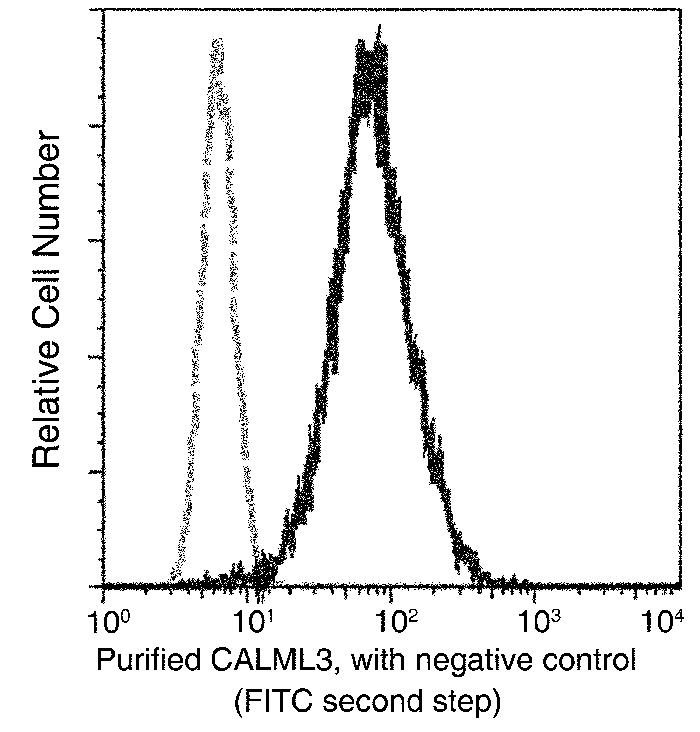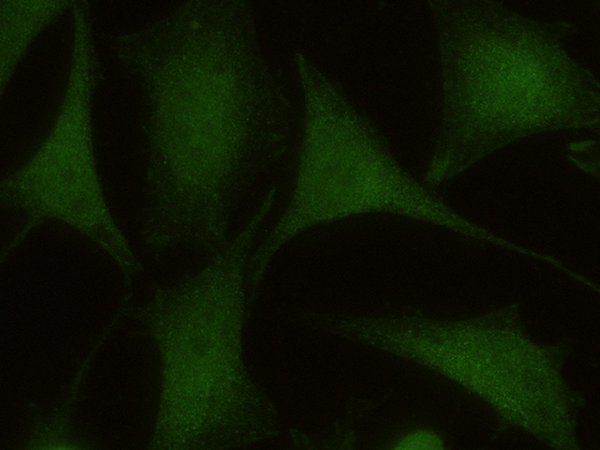-
Product Name
Anti-CALML3 antibody
- Documents
-
Description
Mouse monoclonal to CALML3
-
Tested applications
FCM, IF, ICC/IF
-
Species reactivity
Human CALML3
-
Alternative names
calmodulin-like protein 3 antibody; calmodulin-like protein 3 antibody; calmodulin-related protein NB-1 antibody; caM-like protein antibody; CLP antibody; CLP antibody; AI326174 antibody; 2310068O22Rik antibody
- Immunogen
-
Isotype
Mouse IgG1
-
Preparation
This antibody was produced from a hybridoma resulting from the fusion of a mouse myeloma with B cells obtained from a mouse immunized with purified, recombinant Human CALML3 (rh CALML3; P27482; Met1-Lys149). The IgG fraction of the cell culture supernatant was purified by Protein A affinity chromatography.
-
Clonality
Monoclonal
-
Formulation
0.2 μm filtered solution in PBS
-
Storage instructions
This antibody can be stored at 2℃-8℃ for one month without detectable loss of activity. Antibody products are stable for twelve months from date of receipt when stored at -20℃ to -80℃. Preservative-Free.
Sodium azide is recommended to avoid contamination (final concentration 0.05%-0.1%). It is toxic to cells and should be disposed of properly. Avoid repeated freeze-thaw cycles. -
Applications
FCM: 0.5-2 μg/Test
ICC/IF: 10-25 μg/mL
-
Validations

CALML3 Antibody, Mouse MAb
Flow cytometric analysis of Human CALML3 expression on A431 cells. The cells were treated according to manufacturer’s manual (BD Pharmingen™ Cat. No. 554714), stained with purified anti-Human CALML3, then a FITC-conjugated second step antibody. The fluorescence histograms were derived from gated events with the forward and side light-scatter characteristics of intact cells.

CALML3 Antibody, Mouse MAb, Immunofluorescence
Immunofluorescence staining of Human CALML3 in Hela cells. Cells were fixed with 4% PFA, permeabilzed with 0.3% Triton X-100 in PBS, blocked with 10% serum, and incubated with mouse anti-Human CALML3 monoclonal antibody (15 µg/ml) at 4℃ overnight. Then cells were stained with the Alexa Fluor® 488-conjugated Goat Anti-mouse IgG secondary antibody(green). Positive staining was localized to cytoplasm and nucleus.
-
Background
Calmodulin-like protein 3 (CALML3) is similar to that of authentic calmodulin and may actually compete with calmodulin by binding, with different affinity, to cellular substrates. Calmodulin-like protein 3 (CALML3) is a tumor-sensitive protein specifically expressed in normal epithelial cells but downregulated in tumorigenesis. Downregulation of the protein is an early event in breast cancer development. One of the most pressing questions raised by the discovery of CLP/CALML3 is that of its potential targets. Although it is 85% identical to human calmodulin, the distinct properties of CLP suggest that it has specific targets or targets that only partially overlap with those of calmodulin. Research has identified the unconventional myosin-10 (Myo10) as a specific target of CALML3. The discovery of Myo10 as a specific target of CALML3 is highly significant and suggests multiple lines of further research such as investigations of the Ca2+ regulation of Myo10 and the role of the loss of CLP in epithelial differentiation, adhesion, and cancer. Cells expressing CALML3 displayed a striking increase in the number and length of myosin-10-positive filopodia and showed increased mobility in a wound healing assay.
-
References
- Bennett RD, et al. (2007) Calmodulin-like protein increases filopodia-dependent cell motility via up-regulation of myosin-10. J Biol Chem. 282(5): 3205-12.
- Perochon A, et al. (2011) Calmodulin and calmodulin-like proteins in plant calcium signaling. Biochimie. 93(12): 2048-53.
- Chinpongpanich A, et al. (2011) Biophysical characterization of calmodulin and calmodulin-like proteins from rice, Oryza sativa L. Acta Biochim Biophys Sin (Shanghai). 43(11): 867-76.
Related Products / Services
Please note: All products are "FOR RESEARCH USE ONLY AND ARE NOT INTENDED FOR DIAGNOSTIC OR THERAPEUTIC USE"
